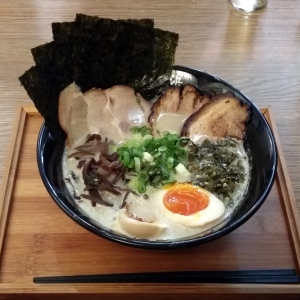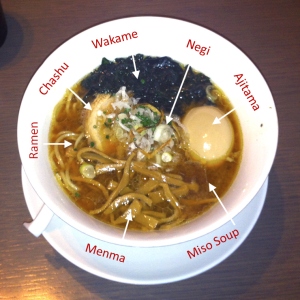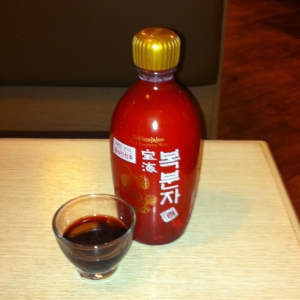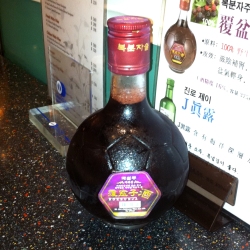(I’ve just updated this old post from 2012)
I‘ve been asked so many times by people about the best local food to try on their upcoming visit to Singapore that I’ve decided to make a post about it, so I don’t have to keep repeating myself. I’m even going to go the extra mile and say specifically where you should eat the top 10 Singapore foods, taking into account how hard it is for a tourist to find certain places. This is not the kind of thing I intended for Kobi’s Kitchen, but since I’m writing it all down, I might as well let everyone see it. It’s a long post, don’t read it for entertainment, save it for when you are going to Singapore.
 As an introduction let me say that Singapore is a great destination for travelers who are into discovering exciting new foreign flavours and foods. Originally a small fishing village, modern Singapore was created through a steady influx of immigrants over a century or so under British rule. Unlike most other countries which have a cuisine culture defined by the surrounding local ingredients, Singapore had no preexisting predominant cooking style. Immigrants from the Hokkien, Teochew, Cantonese and Hainanese speaking parts of China, the Southern parts of India, the Middle East and other parts of Malaya brought recipes from their homeland with them and these were adapted to make best use of the wide selection of ingredients brought in by trading ships from far and wide. Besides being modified, recipes were also hybridized. Singapore was a cultural melting pot and new dishes were created by combining the cuisines from its various sub-populations. This explosive culinary evolution of new foods left the small city-state with a disproportionately large cornucopia of uniquely Singaporean dishes.
As an introduction let me say that Singapore is a great destination for travelers who are into discovering exciting new foreign flavours and foods. Originally a small fishing village, modern Singapore was created through a steady influx of immigrants over a century or so under British rule. Unlike most other countries which have a cuisine culture defined by the surrounding local ingredients, Singapore had no preexisting predominant cooking style. Immigrants from the Hokkien, Teochew, Cantonese and Hainanese speaking parts of China, the Southern parts of India, the Middle East and other parts of Malaya brought recipes from their homeland with them and these were adapted to make best use of the wide selection of ingredients brought in by trading ships from far and wide. Besides being modified, recipes were also hybridized. Singapore was a cultural melting pot and new dishes were created by combining the cuisines from its various sub-populations. This explosive culinary evolution of new foods left the small city-state with a disproportionately large cornucopia of uniquely Singaporean dishes.
In no particular order…
1. Pepper Crab
Pepper Crab something unique to Singapore. It is made from giant Sri Lankan crabs which aren’t all that common outside the sub-continent. The crab is chopped up and then has its shell cracked before it is wok fried to let flavour penetrate right into the meat, which stays nice and firm. When the Pepper Crab arrives at the table, you will enjoy piping hot chunks of crab thoroughly infused with butter and pepper.
The dish was invented at the Long Beach restaurant and that’s where you should go to eat it. The original restaurant is along the east coast where all the seafood restaurants in Singapore used to congregate but today I think the best outlet to go to is Long Beach@Dempsey. It is a newer branch in Dempsy Hill, a former military base (that I worked in once upon a time ) now converted into a lifestyle district full of restaurants, bars and fine grocery stores. Other dishes to try at Long Beach include the Chili Crab and Australian Lobster in Butter and Crispy Cereal.
2. Bak Chor Mee 
While Asians traditionally serve noodles stir-fried or in soup, Singaporeans have a unique style of eating their noodles tossed in sauce. This is the closest thing in Chinese cuisine to Italian pasta. Bak Chor Mee was originally specific to the Teochew Chinese but has since become a national favourite. Egg noodles are boiled and then tossed with oil, vinegar, mushrooms and minced pork, meat balls and other ingredients. The soup that the noodles originally came in is served separately and you are supposed to drink it by itself. After you order some Bak Chor Mee the whole dish will be cooked on the spot right before your eyes. You’ll be asked what kind of noodles you like and I recommend the type called mee pok, its like fettuccine. You’ll also be asked if want chili and you have to say yes or it won’t come out nice. If you don’t like spicy food, ask for ‘less chili’.  ‘No chili’ will land you with a yucky children’s version using ketchup.
‘No chili’ will land you with a yucky children’s version using ketchup.
You can find Bak Chor Mee at the hundreds of locations around Singapore but the place I’d recommend to try it is the food court in the basement of Terminal 3 of Changi Airport. It’s the stall that sells Fishball Noodles. They offer a few different variety of tossed noodles and its the item numbered as 1 (note: for some strange reason it is not the leftmost item on the masthead menu). If it is at all possible, schedule eating this delicacy into your itinerary ahead of time; plan to have it either when you arrive in or when you leave Singapore. If your flight is at a different terminal, just take the free sky train linking all the terminals.
3. Seafood Hor Fun 
I have to eat this every time I go to Singapore. It is basically flat rice noodles fried under high heat to impart texture and a caramelized flavour and then stir-fried with slices of fish, egg white, pork lard and miscellaneous sauces. It doesn’t sound all that fantastic, but believe me when I say it is. Many cooked food stalls and hotel coffee shops will serve this dish but undisputedly, the best place to try this is Ka-Soh Fish Head Noodle. ‘Ka-Soh’ is Cantonese for what the family matriarch calls her daughter-in-law so everything here is cooked in the traditional way passed down from generation to generation. You would think that best Cantonese food should only be found in Hong Kong, but this is clearly a case of an exception to the rule.
The Ka-Soh restaurant is in the Alumni Medical Centre on  the fringes of Singapore General Hospital at 2 College Road, not easy to find or get to if you are a tourist. This is the outlet that was recognized by the 2016 Michelin Guide as a quality restaurant that doesn’t charge an arm and a leg. However I suggest you go to their sister restaurant downtown at 96 Amoy Street, called Swee Kee(Ka-soh). This is actually the older restaurant of the two. You’ll find the walls plastered with the pictures of movie stars and celebrities who have come over from HK to eat there over the years. The other thing to try while you are there is of course is the restaurant’s eponym, the fish head noodle, a milky fish-head broth served with thick vermicelli. I also recommend their fried chicken marinated in prawn paste.
the fringes of Singapore General Hospital at 2 College Road, not easy to find or get to if you are a tourist. This is the outlet that was recognized by the 2016 Michelin Guide as a quality restaurant that doesn’t charge an arm and a leg. However I suggest you go to their sister restaurant downtown at 96 Amoy Street, called Swee Kee(Ka-soh). This is actually the older restaurant of the two. You’ll find the walls plastered with the pictures of movie stars and celebrities who have come over from HK to eat there over the years. The other thing to try while you are there is of course is the restaurant’s eponym, the fish head noodle, a milky fish-head broth served with thick vermicelli. I also recommend their fried chicken marinated in prawn paste.
4. Char Kway Teow 
This is a very, very delicious fried noodle dish that is synonymous with Singapore. Char Kway Teow is also made from Hor Fun but because this dish hails from to a different dialect group (Hokkien), the noodles are called by a different name, Kway Teow. Anyway that is where the similarities end. Char Kway Teow is served dry (i.e. oily), not in a sauce. A combination of flat rice noodles and round egg noodles are fried with soya sauce, egg, cockles, Chinese sausage and bean sprouts to give you a semi-sweet noodle dish to die for.
Char Kway Teow is notoriously hard to fry well and a hundred things can go wrong with it. The quality varies from place to place depending on the cook and ingredients. There are of course many famous Char Kway Teow stalls tucked away deep in suburban housing estates which are difficult to find for non-locals. The place I’d suggest to try is Guan Kee Fried Kway Teow (Char means Fried). Their stall is located in the Ghim Mo Market a few minutes walk from the Buona Vista MRT station. It also happens to be 4 stalls away from the Chicken Rice stall highlighted below in No.8 so you can kill 2 birds with one stone. I would suggest not going at lunch time unless you are prepared to queue for a long time.
5. Islamic Curry 
There are many types of curry in cosmopolitan Singapore and one more special type is made by Indian Muslims. One of the oldest, if not the oldest shops serving this type of curry is the Islamic Restaurant at 745 North Bridge Road. This was my dad’s favourite and he used to tell me stories of how the restaurant gave free food to starving Chinese during the Japanese occupation. The restaurant has down-sized somewhat in recent times and sadly, many of the more traditional curries and drinks are no longer served. However, you can still pick your curry visually at the counter instead of ordering from a menu just like in the old days. You should still be able to order a drink called Bandung, which is rose hip syrup in milk. It’s perfect for cancelling the burning effect of chili effect if you are not used to spicy curry. Make sure to order the in-bone mutton leg and also the chili eggs. Forget about Nann, eat your curry with Briyani Rice.
If the restaurant is full, you can also try the equally famous Zam Zam and Victory, both of which are just a few shops down the road.
6. Kaya Toast 
This is a breakfast item, which is eaten also during morning tea break or afternoon tea. Kaya is a Hainanese egg custard made into a jam, a speciality of Singapore. You normally spread it on toast, typically with a slab of butter. Kaya toast is the Singapore equivalent of waffles with maple syrup, so people eat it any time of the day they like.
For the best Kaya Toast I recommend a place called the Killiney Kopitiam. In case you were wondering, it’s not an Irish pub; the shop is named thus because it is located on Killiney Road and has been there since before World War II. If you can’t make the trip to the original shop, Killiney has one kopitiam at each of all three terminals of Changi Airport. Another thing to try at Killiney is the kopi, which is a bitter shop-roasted Robusta Sumatran blend served with sweet condensed milk at the bottom of a glass mug. You stir the cup just enough to attain the sweetness you like. Leave the last mouthful of the coffee and remaining condensed milk at the bottom. A larger rival kaya toast chain to Killiney is Ya Kun. Their are famous for their pandan flavoured Kaya, which is green instead of brown. There’s no need to provide an address as they have over 40 outlets all over town. To find out more about Kaya, you can refer to my post about Kaya.
7. Laksa 
Laksa is another of those hybrid Chinese dishes with its roots in a subgroup of Chinese intermarried with Malays, called the Nonya. The Chinese part of Laksa is the noodles and slices of fish cake, and the Malay part of it is the rich coconut curry broth the noodles are cooked in. Laksa has a unique flavour to it because of the addition of Laksa leaves and cockles in the broth. The noodles used in Laksa are very slippery and hard to eat with chopsticks and so an innovation called the Katong Laksa in an area of Singapore called… you guessed it, Katong, came about. It is different from normal Laksa only in that the noodles are chopped up so you can eat it easily with a spoon.
Nowadays there is no need to go all the way to Katong to try this. There is a Katong Laksa stall in the trendy Holland Village and that’s the one I usually go to. Its not in the Holland Village Market Food Centre at Lorong Mambong but in a row of shop houses at 31 Lorong Liput. Look for a sign that says 363 Katong Laksa. If you really want to try the original shop (and again this one will be plastered with the photos of movie stars eating their laksa) its at the corner of Ceylon Road and East Coast Road. In either case, don’t forget to ask to add ‘otak’ to your laksa. It is a special kind of fish cake BBQed in banana leaves.
8. Hainan Chicken Rice 
This is a dish that is also universally associated with Singapore, in spite of the fact that it is called Hainan Chicken Rice. In the old days, one group of migrants from China came from the island of Hainan and they were known for their cooking (and laundry) skills. One of the dishes they invented or modified from their hometown recipes, I’m not too sure which it is, was the Chicken Rice. I won’t go into the details of cooking it but the chicken is simmered briefly in stock and then cooled immediately in cold water. Some of the stock together with garlic, pandan leaves is used to cook the rice component. The entire dish is eaten with a fixed set of sauces and condiments without which it is still not Hainan Chicken Rice.
Tourists are often directed to the Mandarin Hotel for chicken rice but it is mega expensive and its Chicken Rice is pretty average. The best chicken rice is made  by Tong Fong Fatt. Besides having the most tender and succulent chicken, it differentiates itself by selling its chicken deboned and drenched in a special tasty marinade. Their stall is at the Ghim Mo Market a few minutes walk from the Buona Vista MRT station, the same food centre where you can find the Char Kway Teow stall mentioned in No.4 above. If you want to have Chicken Rice comfortably in a proper restaurant, then may I suggest Boon Tong Kee at 399 Balestier Road. This restaurant is open late into the night. If you have enough people, you can order a whole chicken. There are several other outlets besides this original shop, including one in River Valley Road.
by Tong Fong Fatt. Besides having the most tender and succulent chicken, it differentiates itself by selling its chicken deboned and drenched in a special tasty marinade. Their stall is at the Ghim Mo Market a few minutes walk from the Buona Vista MRT station, the same food centre where you can find the Char Kway Teow stall mentioned in No.4 above. If you want to have Chicken Rice comfortably in a proper restaurant, then may I suggest Boon Tong Kee at 399 Balestier Road. This restaurant is open late into the night. If you have enough people, you can order a whole chicken. There are several other outlets besides this original shop, including one in River Valley Road.
9. Dai Pau
‘Dai’ means big in Cantonese and a ‘Pau’ is a Chinese steamed bun filled. The Dai Pau can be made with savoury chicken or pork filling (signified with a coloured dot) and will contain a chunk of a boiled egg as well. Dai Pau is dying out in Hong Kong although it is still served in a few banquet restaurants. The Singapore version on the other hand is sold everywhere (even convenience stores and gas stations). Reason: Hong Kong Dai Pau are 70% bun and 30% filling, Singapore Dai Pau are the opposite, 70% filling and 30% bun. Its thinner skin has given the Singapore Dai Pau enduring appeal to young and old alike. You will find the meat filling delightfully juicy, tender and flavoured with various herbs and spices, and slightly sweet. As the name implies, it is large compared to other types of steamed buns like the more common char siew pau.
Since Teck Kee Tanglin Pau wen out of business  Tiong Bharu Dai Pau is the only game in town nowadays. The Tiong Bharu versions are made with a dark filling (i.e. dark soya sauce marinated) which is how you can easily tell it apart from your run of the mill competitors sold at most petrol kiosks. Anyway, their pau can be found in, you guessed it, the Tiong Bharu, or more specifically Tiong Bahru Pau & Snacks at 237 Outram Road (pictured). I understand there is also a popular store selling a similar Dai Pau at the nearby Tiong Bharu Market Food Centre on Seng Poh Road but I’ve never tried it.
Tiong Bharu Dai Pau is the only game in town nowadays. The Tiong Bharu versions are made with a dark filling (i.e. dark soya sauce marinated) which is how you can easily tell it apart from your run of the mill competitors sold at most petrol kiosks. Anyway, their pau can be found in, you guessed it, the Tiong Bharu, or more specifically Tiong Bahru Pau & Snacks at 237 Outram Road (pictured). I understand there is also a popular store selling a similar Dai Pau at the nearby Tiong Bharu Market Food Centre on Seng Poh Road but I’ve never tried it.
10. Bak Chang
This is a rice dumpling normally eaten during the Dragon Boat Festival by Chinese across the globe but in Singapore they are available all year round. An assortment of goodies (depending on which part of China the original recipe is from) are packed into a pyramid of glutinous rice, wrapped in bamboo leaves and then steamed.
The store I’d like to recommend is called Hoo Kee Rice Dumpling and it can be found at the Amoy Street Food Centre #01-18, within walking distance from the Seafood Hor Fun shop mention in No.3. Choose the variety of dumplings that are stuffed with pork, chestnuts and salted egg yolk, they are simply the best. Get there before lunch time for they are often sold out before the lunch hour is over. Another famous place for Bak Chang is Eastern Rice Dumpling at 300 Balestier Road. This is reasonably near the Boon Tong Kee Chicken Rice mentioned in No.8. They have a variety of nice dumplings but one I’d like to highlight is the Nonya Bak Chang. The Nonya are early Chinese settlers of the Malay British Straits Settlements who studied in English schools and adopted many of the local Malay cooking practices. Nonya Bak Chang is therefore quite unique, nothing like any traditional Chinese varieties; as its filling expect a mixture of pork belly, mushroom and candied winter melon flavoured with five spice and pepper. They are traditionally wrapped in pandan instead of bamboo leaves.
Three Bonus Snacks (I know that makes it 13 actually)
A. Old Chang Kee Chicken Wings
Old Chang Kee was a famous stall selling curry puffs next to Rex Cinema in the 1950s which has grown to become a large chain of fast food outlets selling curry puffs. The Old Chang Kee Wings are HUGE and more importantly they are the best fried chicken wings in the world, something to do with the secret marinade they use on the chicken and/or the batter. There are outlets are in many shopping malls so there’s no point singling out one for you. As a local I patronize the outlet at the Barker Road Caltex petrol station next to ACS (where I went to school) and when the lady asks how many wings do you want? The reply is usually “all of them”. OK, while you buying the wings don’t forget to try the curry puffs as well. They are quite nice or Old Chang Kee would not have thrived all these years, plus it is somewhat unique to Singapore. The original puff is called the Curry-O and you should try that first and then if your stomach still has any space left you can think about the other flavours.
B. Cold Ching Teng 
Its pronounced Ching Terng and it means clear soup which is a misnomer because it is not a soup, and neither is it clear. Ching Teng was originally a hot long-an(a fruit) soup back in the old days in China but in Singapore it had evolved into a cold dessert served with shaved ice. There are bits and pieces of all kinds of things in it like pearl barley, dried persimmon, ginko nuts, lotus seeds and of course rehydrated dried long-an. It’s perfect for quenching the thirst on a hot day (basically every other day in Singapore) or as a dessert after eating curry or food with chili. One famous place serving this is Shan Ren Cold and Hot Dessert at the Newton Food Center, its stall no. 88. There’ll be dozens of other desserts pictured on the store front so you can try a few other desserts while you are there. If you like something with more shaved ice, try Ice Kachang, another Singaporean specialty.
C. Bak Kwa
Bak Kwa is the local name for barbecued pork jerky. Unlike western beef jerky, Bak Kwa is not tough. The meat is vacuum treated to tenderize it and then it is barbecued with sugar and spices and all things nice. The leading brand Bee Cheng Hiang has shops everywhere so you no longer have to go to Chinatown to buy it. Check their website for a convenient location. I recommend the Golden Coin or Minced Pork type Bak Kwa if you like a really tender piece of jerky. They also sell pork floss if you are into something drier.
Other Contenders for the Top 10
Many of these are just as good but I didn’t want my list to expand to a top 20 list, its already long enough. Try them, especially if you are on an extended visit.
-
- Fried Carrot Cake
- Hokkien Prawn Noodles
- Chinese Pork Satay
- Oyster Omelette
- London Duck (Four Seasons Restaurant at Capitol)
- Ngoh Hiang
- Poh Piah
- Roti Prata
- Kweh Lapis
- Pineapple Tarts




































 Other types of desiccated shellfish like whelk, conch and squid are also used in the same way. All of these should be soaked and softened in cold water for an hour or so before being added to the soup (together with the soaking liquid).
Other types of desiccated shellfish like whelk, conch and squid are also used in the same way. All of these should be soaked and softened in cold water for an hour or so before being added to the soup (together with the soaking liquid). 
